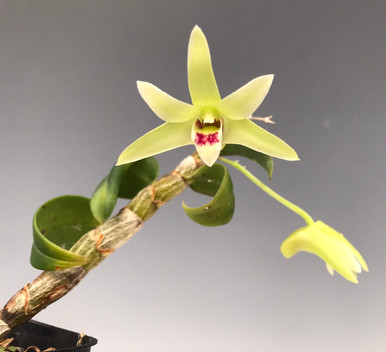Section Formosae Dendrobium Orchid Care
A unique section of Dendrobiums found naturally throughout South Asia and the Philippines. Also known as Nigrohirsute Dendrobiums, species in the Formosae are easily identified by the fine black hairs that cover the canes. Formosae species and hybrids exhibit large, showy flowers that often feature ‘horned’ sepals and vibrant, textured lips. Many species in this group, such as Den. bellatulum, require a drier, cooler winter rest period to remain healthy and flower well. Seasonal species and their derivative hybrids are often partially to fully deciduous and will flower annually on mature canes that have previously dropped their leaves. Common species include Den. bellatulum, Den. cruentum, Den. formosum, Den. lowii, Den. sanderii, Den. shuetzei, and Den. tobaense.
Light and Shade
Formosae Dendrobiums grow well with bright, indirect light. Filtered light from south- or east-facing windows will suit plants of this Section well. Avoid extended exposure to direct sunlight, particularly in the afternoon and early spring mornings. Plants receiving a winter rest can receive brighter light during that time period.
Temperature and Humidity
Variable from cool to warm, depending on the species or hybrid. Species with more tropical origins like Den. tobaense respond well to intermediate to warm temperatures year-round (62F minimum night / 85F maximum day). However, other species like Den. bellatulum require a cooler winter rest where temperatures can drop to between 45/65F day/night from approximately mid-November to early April. Hybrid varieties in this section are more tolerant of variable year-round temperatures, but depending on parentage may also respond favorably to cooler winter rest periods. Most Formosae will appreciate a relative humidity of 60% to 85% accompanied by good airflow year-round, though reduced humidity can accompany winter rest periods.
Watering & Feeding
From late spring to early fall while active growth is visible, watering should remain consistent just as the plants approach dryness. During this time period, fertilizer can be applied regularly if potting media-appropriate practices are followed. However, during the winter rest period from approximately mid-November to early April, watering should be drastically reduced and fertilizing suspended. Plants should only be lightly moistened at the roots if the canes show signs of shrinking/wrinkling. Watering and fertilizing should only resume once new growths have emerged and begun producing new roots in the spring.
Potting
Plants of this section can be grown in a medium to small bark-based mix or New Zealand sphagnum moss in any type of well-draining container, as long as appropriate watering practices are observed. Formosae Dendrobiums prefer to be under-potted in similar fashion to their other relatives. It is best to wait to repot these plants until new growths and accompanying roots have begun to emerge, unless an emergency dictates otherwise. Do not re-pot or re-mount Formosae Dendrobiums during the winter rest period. Smaller species like Den. bellatulum grow well mounted on materials with low moisture retention like cork or cedar shingles, which naturally lend themselves to rapid drying during the winter rest period.
Pest Control
The main pest that Dendrobium attract are mealybugs, which will hide in the axis where the leaf meets the cane. The best treatment for mealybug is either a homemade pesticide of 1:1 parts water & rubbing alcohol, with a few drops of dish soap added. Spray the plants every few days, washing off the dead bugs in between. For large outbreaks, an application of a specially formulated pesticide spray every few days is more effective.
Featured Products
Shop all →




